Five Places You Must Visit During Spring in Croatia
March 10, 2022 - This month, the frigid temperatures and strong winds of winter have already begun to turn into warm and colorful days, thus welcoming spring. Is it worth visiting during this time of year? Of course. And here are five places you cannot miss during spring in Croatia.
Winter in Croatia is a difficult concept to criticize. Despite low temperatures, strong winds, snow, or rain, Croatians have always found a way to positively view the arrival of the winter months. In central and eastern Croatia, the cold and snow are not strong enough to break the spirit of its inhabitants. Winter is synonymous with the holiday season, with cities and towns brightly and colorfully decorating their streets, and filling their parks and plazas with fairs and concerts.
In the same way, along the Croatian coast, the locals take back the cities from the tourists and the storms are intermittent since sunny days predominate. Thus, the people who live in front of the Adriatic find a great excuse to put on their best coats, their sunglasses, and get together with their friends and family to have a coffee in the rivas and old towns of their cities.
However, it is true that when the day darkens at five in the afternoon or the temperature of the sea is too cold to take a dip, summer days are missed throughout the country. For this reason, the arrival of spring is always welcome in Croatia and invites those who reside in the country to venture outside their homes without having to wear more than two pieces of clothing. The beginning of spring in Croatia is March 20, and so that you can plan your next adventure, we share five places that you cannot miss at this time of year.
Zagreb
Perhaps the first thing that comes to mind when thinking of spring in Croatia is some of its 8 national parks or 12 nature parks. However, the Croatian capital of Zagreb is literally a spectacle of colors and a great atmosphere during this time of year. Although the official date for the beginning of spring is still 10 days away, the inhabitants of Zagreb are already witnessing the first blooms in their avenues, streets, and parks. If you're coming to Zagreb during spring, you probably won't know where to start.
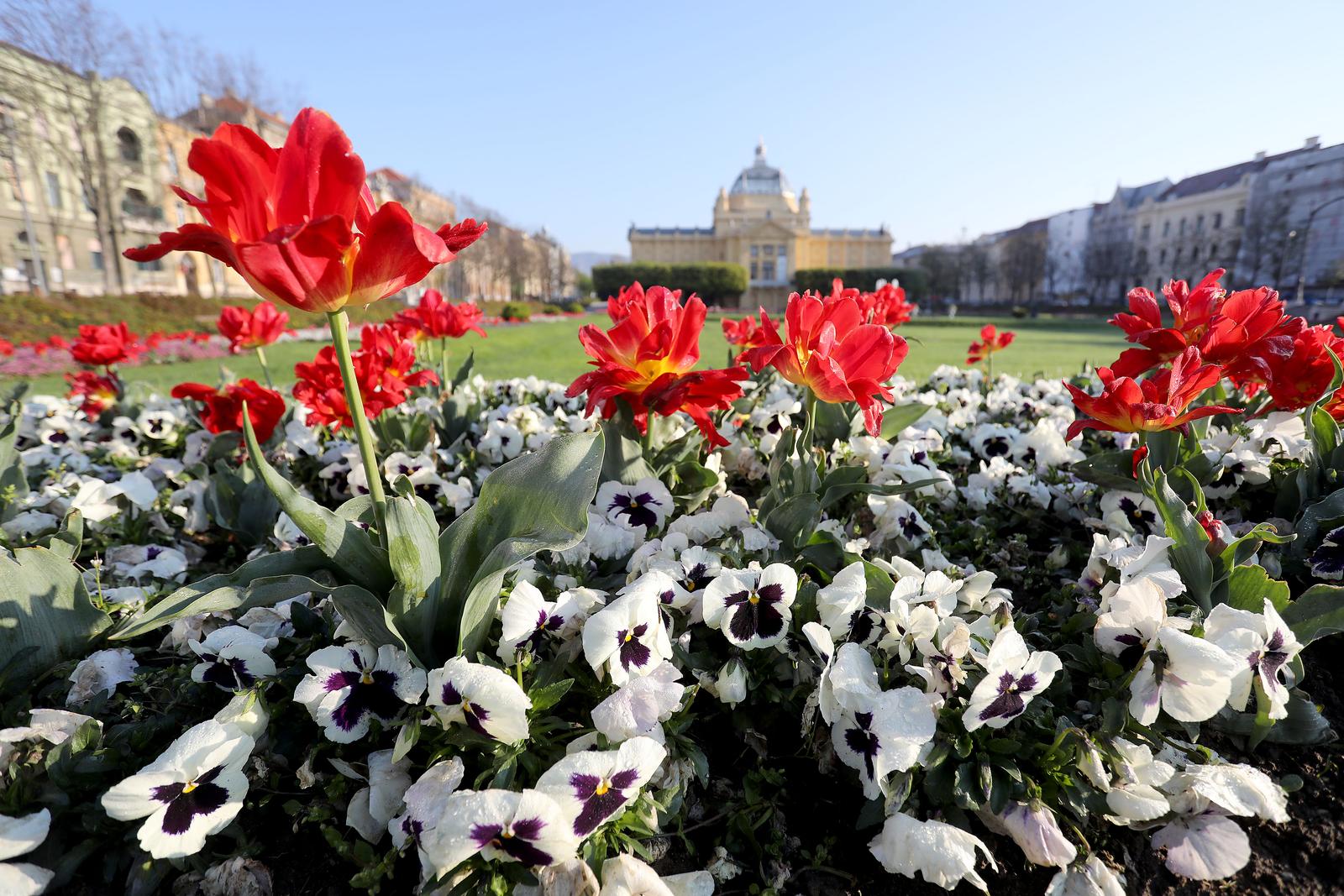
Flowers blossoming in the gardens of King Tomislav Square. (Photo: Patrik Macek/PIXSELL)
Stroll through the beautiful parks in Zagreb's upper town, from Zrinjevac to King Tomislav Square, where you could even sit in its gardens reading a book while enjoying the atmosphere and the colors of its flowers and trees. If you want to go for exercise and at the same time enjoy the blossoming in the spring, visit the parks of Jarun, Bundek or Maksimir, in which you could also organize a picnic with your friends. Or maybe organize a walk through the Zagreb Botanical Garden, in the upper town of Zagreb. You will see that when you get home and check your phone, you will have probably taken more than a hundred photos throughout the day. Zagreb is home to many of the best spots to be during spring in Croatia.

Cherry trees in the district of Prečko, Zagreb. (Photo: Igor Kralj/PIXSELL)
Bonus tip: visit Šulekova street in Zagreb in Spring, which has become famous for its spectacular colors thanks to the blossoming of its cherry trees. Don't forget to go with someone who can take amazing pictures of you for your Instagram!
Plitvice Lakes National Park
It really is impossible not to highlight the national and natural parks of Croatia when talking about a change of season. I do not mention a season in particular because each one offers something magical and different. For example, when we talk about Plitvice Lakes National Park, we cannot compare the four seasons, just enjoy them to the fullest. Autumn's intense red and orange colors beautifully contrast with turquoise lakes, resembling a frame straight out from a fairy tale. Winter covers the park with snow, and the result is a mixture of whites and turquoises that will make your jaw drop. And not to mention the summer, where the green forests also serve as a refuge from the high temperatures with their shade.

Plitvice Lakes National Park, stunning all year round. (Photo: Vedran Bozičević)
But we all know that, in a place as diverse in flora as the Plitvice Lakes National Park, it is essential to witness its colorful show during spring. It's arguably the perfect time, as it's neither too cold nor too hot to overwhelm you as you wander through the park, and it's one of its most photogenic times of the year!
Find HERE the prices and rates of the tickets to visit the Plitvice Lakes National Park.
Split
We also don't want to overwhelm you with a shower of colors, if that's not your thing. And it is not because Split does not have them, but the experience of spring in the Dalmatian city is lived in a different way. Spring in Croatia comes in different shapes and colors. Although the trees and parks of Split are also beginning to regain their leaves and greenery, the arrival of spring means that the return to the sea and the beaches is getting closer. You will feel that wearing a coat could be unnecessary, with temperatures that can rise up to 17 degrees. Even with the water still relatively cold, some brave souls are already starting to visit the city's beaches to take a dip, realizing that the frequent sunny days and rising temperatures will dry them out quickly once out of the water.

The Diocletian Palace in Split, not during summer, but in April. (Photo: Milan Sabic/PIXSELL)
But without a doubt, the most exciting thing about spring in Split is the progressive reopening of many restaurants, bars, and cafes throughout the season, which have already finished their respective maintenance and are beginning to prepare for the arrival of the busy summer. If you were in Split during the winter, and you will stay here until at least the beginning of summer, you will witness a city that is becoming active every day. Also, ferry lines are starting to increase and you can have the privilege of visiting more islands and destinations without the crowds. And beware, enjoying spring in Split is something that can be replicated throughout the Croatian coast, from Istria to Dubrovnik!
Krka National Park
If you change your mind and would indeed like to see the spring in Croatia blooming at its best, there will always be a national park or nature park near you. The Krka National Park has nothing to envy Plitvice Lakes since its sixteen plunging waterfalls, winding hiking trails, and vast expanse of lush, green forests place it as one of the most visited destinations in the entire country. Krka, apart from being recognized for its spectacular sceneries, is also a very popular destination for adventure lovers. Whether on foot or by bicycle, it is never enough to discover all the wonders that the national park hides. And if you had to pick an ideal time of year to visit, the spring months should be at the top of your list.

Very close to Šibenik, and less than an hour from Split - Krka National Park. (Credit: Krka National Park)
Although the new measures taken by the National Park, which prohibit visitors from bathing in the falls, have reduced the saturation of people in the main circuit of Krka, summer is still the time of year with the highest volume of tourists. If you are looking to connect better with the nature of Krka, you will surely find it in spring with almost as pleasant weather, colors everywhere, fewer people, and... cheaper prices!
Find HERE the prices and rates of the tickets to visit the Krka National Park.
Osijek
Of course, spring comes everywhere, and not only on the coast and in central Croatia. Moreover, it could be said that spring in eastern Croatia arrives with incomparable intensity. The vast forests, fields, and crops in Slavonia and Baranja are a visual delight both for those viewing it from above with their drones, as well as for those on foot. This part of Croatia is often mistakenly considered a cold, nothing-happening region, but few have the privilege of enjoying its energy and warmth all year round, even in the harshest of winters. And all the more reason, you'll want to check it out for yourself in a season with better weather and full of greenery.

Cherry trees in King Krešimir IV park in Osijek. (Photo: Davor Javorovic/PIXSELL)
There are so many places to visit in this region during spring, but what better place to start than in the largest city in eastern Croatia, and the fourth largest in the country. Osijek is famously known as the greenest city in Croatia, with more parks and public green areas than any other town in Croatia. Wherever you go in Osijek during the spring, you will come across an immeasurable number of trees and gardens full of vibrant colors. Some of the parks that you cannot miss are King Tomislav Park, Sakuntala Park, or King Krešimir IV Park, protected as the first monument of park architecture in Croatia.

Cherry trees in King Krešimir IV park in Osijek. (Photo: Dubravka Petric/PIXSELL)
These are just five examples of places that you cannot miss during spring in Croatia, but believe us when we tell you that the whole country, throughout its territory, has some magic waiting for you during the most colorful season of the year.
For more on travel in Croatia, follow TCN's dedicated page.
Zagreb to Dubrovnik: the Ultimate 10-day Road Trip Itinerary
21 February 2022 - It’s never the wrong time to start planning the perfect getaway to the paradise that is Croatia. We decided to give you a hand in planning the perfect 10-day road trip from Zagreb to Dubrovnik (plus some bonus island time!) that showcases the best the country has to offer.
The best way to discover Croatia is by car, giving you the freedom to go off the beaten path and chart your own adventure around the country, all the way from Zagreb to Dubrovnik.
Before we jump into it, do be aware that most car rentals in Croatia are manual transmissions! Automatic cars are available for rent, though mostly by larger rental companies like Sixt, and are more expensive.
If you’re not a confident driver, no need to worry, there are plenty of private bus companies that run daily trips to most cities and tourist attractions during the high season (June - September). In larger cities such as Zagreb and Split, bus schedules are also available online. Transfers between major ports and the islands are also regularly serviced by ferries and catamarans.
Day 1: Zagreb
Welcome to Zagreb, the capital and largest city of Croatia! Nicknamed the city of museums, Zagreb is home to over a dozen award-winning museums such as the Archeological Museum, with over 450,000 artifacts and monuments.

The gorgeous buildings of Upper Town in Zagreb. Visit Zagreb/Facebook.
Cultural landmarks of the city include Ban Jelačić Square which has existed since the 17th century, the Zagreb Cathedral, or the magnificent Croatian National Theater whose unveiling ceremony was attended by Austro-Hungarian Emperor Franz Joseph I. So, make sure you squeeze in some time for a walking tour to absorb the sights of Zagreb’s Old Town.

Evenings on Tkalčićeva Street, Zagreb. Visit Zagreb/Facebook.
Hungry? Head to Dolac market, Zagreb's main open-air farmers market to pick up some fresh, seasonal produce and souvenirs. You can also choose to end your day with a tasty meal and local wine from any of the excellent restaurants, bars, and cafes along Tkalčićeva Street.
Day 2: Rovinj
After a bustling day in Zagreb, the enchanting city of Rovinj is a splendid change of pace. Perfectly situated on the Istrian peninsula, the city boasts a rich heritage, from being settled by Venetian tribes, to becoming part of the Byzantine and Frankish Empires, all reflected in the diversity of the city’s architecture, art, and culture.

This stunning setting has been a popular film setting for movies such as "The Hitman's Wife's Bodyguard". Rovinj Tourist Board/Facebook.
Stroll along the beautiful cobbled streets and narrow alleys of Rovinj Old Town and make your way towards St. Euphemia Cathedral. Along the way, you should pass by Grisia Street, lined with souvenir stalls and galleries with the most unique pieces to add to your collection.
The charming, picturesque streets of Rovinj's Old Town. Rovinj Tourist Board/Facebook.
If you have time to spare, take a day trip to Sveta Katarina, a small picturesque island that’s a mere 10-minute water taxi ride from the pier. Spend the afternoon taking a dip in the aquamarine waters of the bay, or hike on one of the numerous trails dotted around the island, or both!
Alternatively, sit back and relax on some of the most beautiful beaches in Istria such as Amarin, Borik, or Valdaliso Beach.
Day 3: Pula
Before leaving the Istrian Coast, make Pula the next stop on your road trip. Serving as the capital of Istria, Pula was the main military port for the Austro-Hungarian Monarchy at the height of its military glory. Today, remnants of these times are reflected in the city’s breathtaking landscape.

The Pula Arena frequently hosts concerts and festivals throughout the year. Pula Plus/Facebook.
The famous Pula Arena, one of the most well preserved Roman amphitheaters in the world, is a must-see! Another not to be missed landmark is the Temple of Augustus, a monument dedicated to the first Roman emperor in honor of his rule.

The unique shape of Fort Puna Christo. Pula Plus/Facebook.
Also check out the impressive Fort Punta Christo, which includes an underground section to explore and a well-stocked rooftop bar for refreshments after. You can also enjoy magnificent 360-degree views of Pula from the Venetian Fortress (Kaštel) which also houses the Historical and Maritime Museum of Istria.
Day 4: Plitvice National Park
Although Croatia boasts some of the best coastlines in the world, Plitvice Lakes National Park consistently appears in the top must-see places to visit in Croatia, and for good reason! This UNESCO World Heritage Site holds the title as the oldest and largest national park in Croatia, famous for its gorgeous turquoise lakes. Well worth the detour inland.
 The main walkway of Plitvice Lakes National Park. Plitvice Lakes National Park/Facebook.
The main walkway of Plitvice Lakes National Park. Plitvice Lakes National Park/Facebook.
Be aware that the park can get very crowded during the season! To avoid this, just be prepared to visit early (7-8am), or better still, stop by during off-peak seasons where the park transforms into the perfect winter wonderland.

Plitvice Lakes National Park/Facebook.
Day 5: Zadar
After a day in the lush forests, take a scenic drive back to the Dalmatian coast and spend a day in the charming city of Zadar, the oldest continuously inhabited Croatian city. Today, cozy cafes and art galleries are seamlessly woven into remains from the times of Julius Caesar and Emperor Augustus.
Enjoy a relaxing stroll through Old Town and admire the historical architecture including the Church of St. Donatus, the Landward Gate, the Cathedral of St. Anastasia, and the Roman Forum.

Ruins in the Old Town of Zadar. Zadar Region/Facebook
Along the way, catch the famous Sea Organ, and a sunset so beautiful, it even captivated Alfred Hitchcock! Just after sunset, take in the light show at the Sun Salutation, an installation created by Nikola Bašić, the same artist who designed the sea organ.

The Landward Gate, Zadar. Zadar Region/Facebook
If you have some time in between, head to Pag Island to try some of the famous Paski Cheese or to Nin, home to Queen’s Beach, the longest sandy beach in Croatia. Other gorgeous beaches along the coast of Zadar include Kolovare and Borik.

Award-winning sheep's cheese from Pag Island. Pag Tourist Board/Facebook.
Day 6: Split
Welcome to Split, the largest city in Dalmatia, and second-largest in all of Croatia. The city was founded as the Greek colony of Aspálathos between the 3rd and 2nd century BC.
It was later where Diocletian's Palace was built for the Roman emperor in AD 305. The palace also houses the Peristil, or the main square, another great place to enjoy some coffee and people-watch in addition to the Riva promenade.

Enjoy a drink inside the walls of the Diocletian's Palace, Split. Visit Split/Facebook
While exploring the Old Town, stop by the Green Market, the largest farmer’s market in Split, to pick up some fresh, organic produce. Turn the corner and it is difficult to miss the 8.5-meter statue of Gregory of Nin, sculpted by world-renowned artist Ivan Meštrović. Rubbing the statue’s toe is said to bring good luck, so much so that it has been worn smooth by visitors over the years.
You can also squeeze in a light hike up Marjan Hill, also known as the “lungs of Split”. Its summit is an ideal place for a picnic, offering marvelous views of the harbor and neighboring islands.

The crystal clear waters of Bačvice beach. Visit Split/Facebook
Fancy another beach day? Bačvice beach is a popular hangout spot in the center of Split. Relax at one of the many cafe bars and watch the locals play picigin, a traditional ball game. Rumor has it this beach is also where the sport originates from.
Day 7: Krka/Omiš/Trogir
Don't be too quick to leave Split. From here, there are several options for day tours to surrounding attractions.
Some of the most stunning waterfalls in Croatia can be found at Krka National Park. Krka Nationa Park/Facebook
For nature lovers, Krka National Park is another national park about an hour’s drive from Split. Spend a day walking along well-maintained trails that wind along some of the most stunning waterfalls in the country. Again, make sure you get there early to avoid the crowds!

Try white water rafting in Omiš. Tourist Board Omiš/Facebook
For those craving more action, head to the picturesque town of Omiš which offers one of the most dramatic scenes on the coast. The city is nestled in a canyon surrounded by gray, craggy mountains, contrasting the peacock blue waters where the Cetina River meets the Adriatic Sea. Omiš offers white water rafting, free climbing, ziplining, abseiling, and canyoning, amongst other activities for visitors seeking a bit of a thrill on their vacation.

Just one of the many well-preserved remains scattered around Trogir's Old Town. Visit Trogir/Facebook
For the history buff, head to Trogir which has the best-preserved Romanesque-Gothic complex in all of Central Europe. Take a walk around the Old Town, surrounded by walls comprising a series of dwellings and palaces from the Romanesque, Gothic, Renaissance, and Baroque periods.
Day 8: Hvar
With over 1,000 islands, it wouldn’t be a complete trip to Croatia without doing some island hopping. From Split, take the 1-hour ferry ride over to Hvar. Its beauty and vibrant nightlife have made it a regular vacation spot for the likes of celebrities such as George Clooney and Beyonce.

Hvar is one of the longest and sunniest islands in Croatia. Hvar Tourist Board/Facebook
Start by wandering around St. Stephen’s Square, the largest square in Croatia and don’t miss the Cathedral of St. Stephen and the Hvar public theater. For the best view, climb to the top of the Španjola Fortress to get an unobstructed view overlooking Hvar Town and nearby Pakleni Islands. You can even rent a small boat (no license required) to explore these islands on your own!

The view from the top of the Španjola Fortress is unparalleled on the island. Hvar Tourist Board/Facebook
Once you’ve taken in all these sights, enjoy another relaxing beach day at one of the many pristine beaches such as Malo Zaraće, Dubovica, or Pokonji Dol.
Alternatively, if you’re looking for another day trip, book a tour with one of the local travel agencies to the Blue Caves on Biševo and marvel at its clear, iridescent blue waters.
Day 9: Korčula
After the buzz of Hvar, take the ferry to the tranquil town of Vela Luka on the island of Korčula, the birthplace of famed explorer Marco Polo and home to some of the best Croatian wines.
From Vela Luka, take a scenic drive towards the town of Korčula, also known as “little Dubrovnik”. Along the way, stop by the numerous family-run vineyards that welcome visitors for wine and cheese tastings.
Grk is a white wine variety grown almost exclusively on Korčula, other white wines such as Pošip and Rukatac are also premier Croatian wines, often served on celebratory occasions. For fans of red wine, do grab a bottle or 2 of Plavac Mali.

Vineyards of Korčula island. Visit Korčula/Facebook
In Korčula, walk off the afternoon’s indulgences exploring the streets of the Old Town with its architectural influences by the Venetian Renaissance, before capping off the night with a meal and more wine at any of its superb restaurants.

Korčula town. Visit Korčula/Facebook
Day 10: Dubrovnik
There’s no better way to end the trip than with Dubrovnik. And yes, there is no shortage of Game of Thrones tours to indulge your senses, but there is so much more to this medieval city than where Cersei Lannister did her walk of shame.

The beautiful Saint Blaise's Church in Dubrovnik was built during the 10th century. Dubrovnik Tourist Board/Facebook
Talk a walk along the city walls and through Stradun, Dubrovnik’s main street. From here, you can also catch Onofrio’s Large Fountain that used to supply Dubrovnik with fresh water during the Middle Ages and other impressive structures including the Clock Tower, Saint Blaise's Church, Saint Ignatius Church, Cathedral of the Assumption, and the Franciscan Monastery.

The view from beyond the walls of Dubrovnik looking upon Fort Lovrijenac. Dubrovnik Tourist Board/Facebook
Watch the sunsets and reminisce on your amazing road trip through the country at one of the cliff bars along the city walls, before capping it all off with an exquisite meal at one of the many Michelin-starred or recommended restaurants Dubrovnik has to offer.

Nothing like a luscious meal to top off a fantastic experience road-tripping in Croatia. Dubrovnik Tourist Board/Facebook
And that’s all folks, you’ve done it! Croatia in 10 days! Bear in mind, this is merely the appetizer of what Croatia has to offer. Customize this guide to better suit your tastes and pace and remember, don’t hesitate to ask the locals in order to unlock the best secrets each location has to offer.
For more on travel in Croatia, follow TCN's dedicated page.
Krka National Park to Introduce New Entrance in Šibenik
February 10th, 2022 - The new gateway to Krka National Park will relieve the pressure on two other entrances used by 95% of visitors, and make it easier for tourists in Šibenik to visit the national park
A new entrance to Krka National Park is about to be opened in Šibenik, reports Morski.hr. The Dalmatian town is set to become the sixth official gateway to the magnificent park, a natural karst phenomenon, along with Skradin, Lozovac, Roški Slap/Laškovica, Burnum/Puljane and Kistanje/Manastir Krka.
The overwhelming majority of visitors, about 95%, enter Krka National Park via Lozovac and Skradin entrances, the latter being the closest to the majestic Skradinski buk waterfall. Introducing an entrance in Šibenik is hoped to relieve the pressure on the two mentioned entrances, and distribute visitors evenly throughout all the sites in the park and at the reception centres.
The decision to introduce an official park entrance in Šibenik is a part of the Action plan for visitor management in the period 2019 - 2031, but a strategic project as well.
‘We were of the opinion that this high percentage [of visitors] needs to be more evenly distributed and that a possibility of opening a new entrance to Krka National Park in Šibenik needs to be considered. We proposed the idea of reception and transport of visitors in the city of Šibenik, who spend an average of three days staying in accommodation facilities in town and on islands of the Šibenik archipelago. We also had in mind the citizens of Šibenik to whom the Krka waterfalls are a synonym of the Park and their favourite destination. Naturally, we also thought of new visitors from the two neighbouring counties, who could choose the Šibenik entrance as a jumping off point for their visit to Krka National Park’, said Krka NP director Nella Slavica.
It’s believed that this new concept of visitor reception will help solidify the position of Šibenik on the tourist map and increase the number of visitors to the city, who will then go on to avail of other tourist services in town.
Šibenik Mayor Željko Burić brought up a few steps the City of Šibenik is planning to take to ensure the best possible outcome of their cooperation with NP Krka. ‘A necessary step in the implementation of this project is to introduce regular bus and boat services for visitors, as well as a commercial space for presentation of the Public Institution "Krka National Park" in Šibenik', said Burić.
KK Split Celebrates 87:77 (38:33) Victory in ABA League
November 12, 2021 - Krka delivered a good fight, but Hasahn French's injury in the 3rd quarter helped bring KK Split the victory.
KK Split started the game at the bottom of the ABA League table after seven completed games with only a single win so far against Cibona during their last encounter on October 31st. However, the victory was close and resolved only by a single point with 77:76 for the Yellows (and meant an impressive series of 10 consecutive wins against the team from Zagreb). Krka arrived in Split from Slovenia with three wins out of seven games, making them 10th in the table. Since all the guest’s wins were during their home games, KK Split hoped to make up some ground and establish a position in the race to stay in the league.

Burak Canboy
The game went back and forth in the first minutes while both teams tried not to make too many mistakes and concentrated on their outside shooting. After a first 6:6 tie, both sides threw in two successful threes to tie the game again at 12:12 before home coach Srđan Subotić had his men defend much more aggressively and saw it rewarded with a 20:14 lead by the end of the first quarter.
However, the guests from Novo Mesto, who are currently leading the Slovenian national league, did not give up and got back into the game and continued to do so every time that the Yellows seemed to pull away.
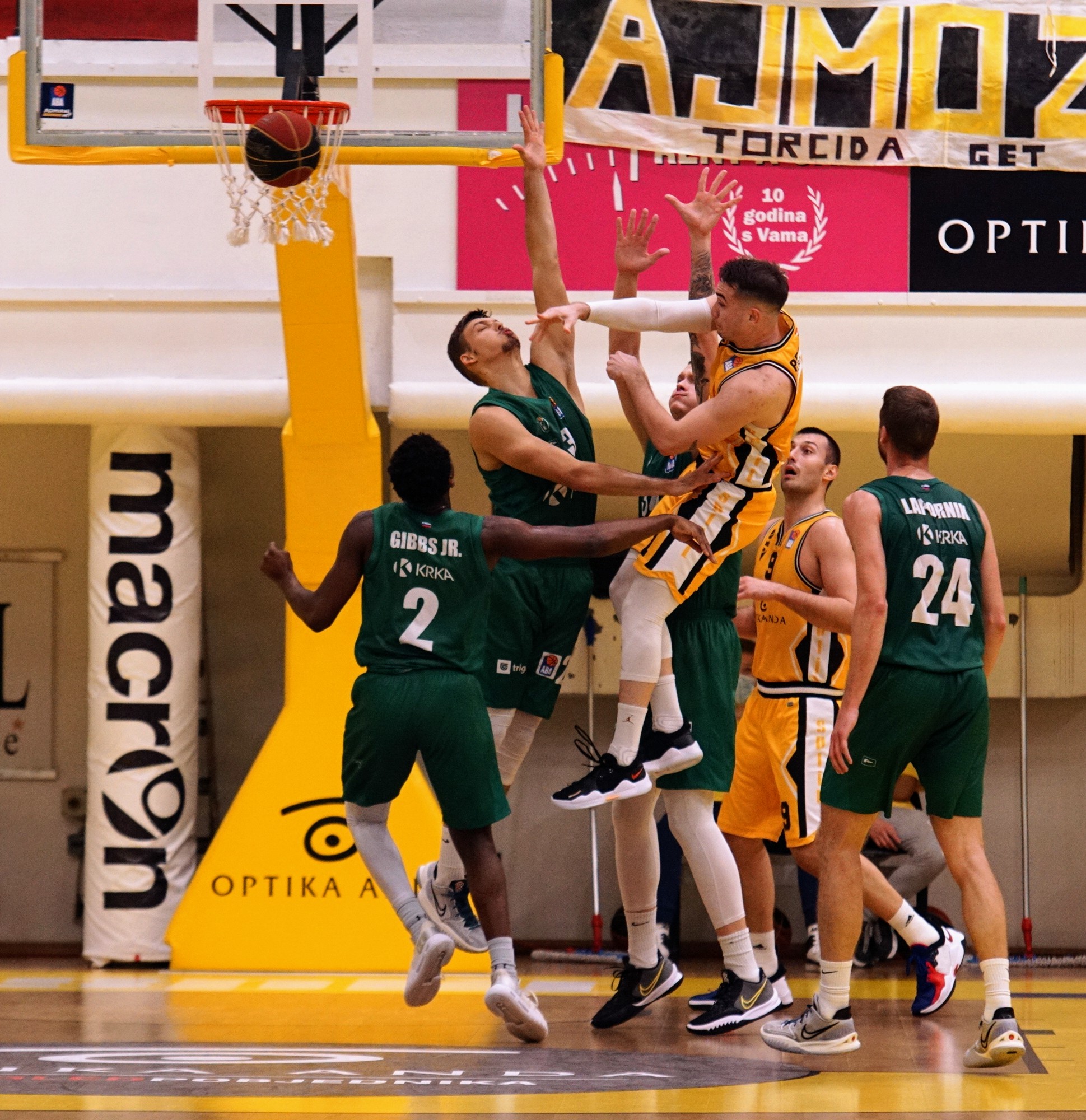
Burak Canboy
Krka coach Dalibor Damjanović lost his cool several times and was not happy with the referees' calls. Finally, in the third quarter, he was punished with a technical foul after seeing his star player Hasahn French being fouled and falling down hard. The center had to be escorted off the field injured and was not able to return.

Burak Canboy
Even without their big man, the team in green fought back again and stayed only a few possessions behind Split until the key moment of the game. Three and a half minutes to go at 75:73, a three-pointer by KK Split guard Barić then a steal followed by a fast-break lay-up for 5 points within just seconds first broke Krka's motivation two dunks by Bajo in the following two possessions broke their neck and sealed the victory.
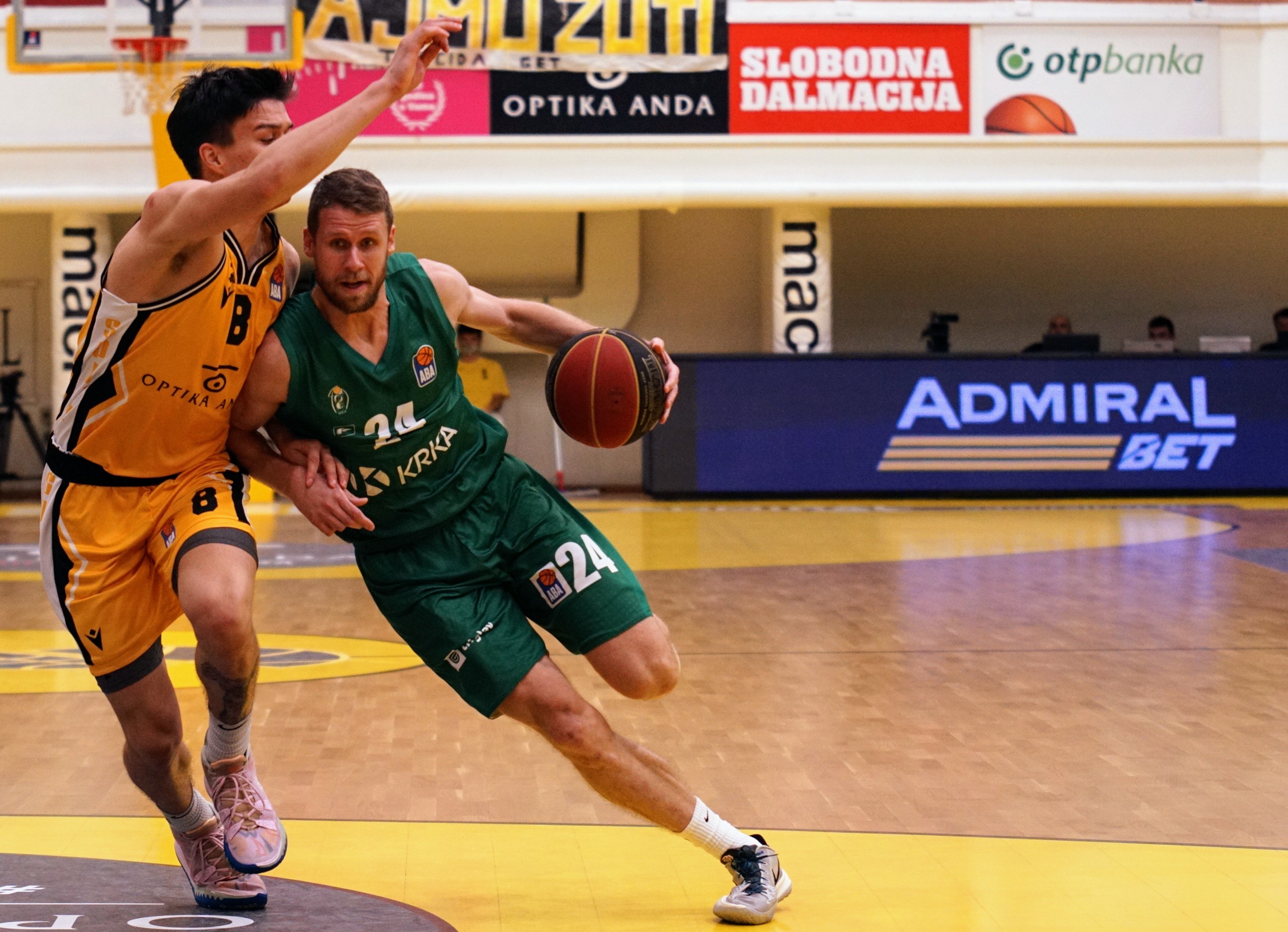
Burak Canboy
Despite Split scoring 25 points from turnovers and leading in most statistical categories, the game could have gone either way and was a very attractive game to watch. Instead, the spectators got to see plenty of dunks and good outside scoring with the better end for the home team.
Six yellow players ended up scoring in double digits, led by Nejc Barič, who delivered a convincing game and shone in clutch situations. With 20 points and 10 assists, he was named Man of the Match. The top scorer for Krka was point-guard Stipčević, who had to play the entire 40 minutes, made 3 of his 4 three-point attempts, and totalled 19 points.
Referees: Marko Juras, Dragan Porobić, Radoš Arsenijević
Box Score: https://www.aba-liga.com/match-live/50/21/1/Boxscore/q1/1/home/split-krka/
Krka National Park Offers Promotional Entrance Fee Until October 31st
October 26, 2021 - As it joins the promotional campaign of Croatian Tourism Month, Krka National Park offers a special ticket price for all its attractions, which will be valid from October 25th to 31st.
With a special ticket price for all land sites in the Park of 65 kn for adults and 52 kn for children aged seven to eighteen, which will be valid from 25 to 31 October, Krka National Park offers an interesting discount and thus joins the promotional campaign Croatian Tourism Month, which is carried out by Ministry of Tourism and Sports and the Croatian National Tourist Board, reports Turističke Priče. For children up to the age of seven, entry to the Krka National Park has always been free.
The aim of the action is to encourage the citizens of the Republic of Croatia to get to know and visit different parts of our country at better prices for many tourist services and products, from the accommodation, transport, and sightseeing to catering services and various experiences, with the aim of encouraging domestic tourism and increasing tourist traffic. in the off-season.
Every season on the Krka is special for some reason. Painted with autumn colors, Krka provides a real experience: pleasant temperatures, the liveliness of flora and fauna, plenty of water, pronounced geomorphological forms of rocks, and travertine. In addition, the enjoyment of mastering the educational hiking trails and cycling routes will make the visit unforgettable. Krka National Park includes the largest and most beautiful part of the Krka River and the lower course of the Čikola River. The basic phenomenon of the Krka National Park is tufa, which, along the entire course of the river, has formed seven enchanting travertine waterfalls. The most famous and most visited waterfall, Skradinski buk, is the longest travertine barrier in Europe.
The Skradinski buk and Roški slap sites are open for visitors from 9 am to 5 pm in October, and the upstream sites from 10 am to 5 pm, the Krka National Park reported.
Krka National Park is an absolute gem, with a range of fantastic things to see and do for all the family. In partnership with Krka National Park, we are delighted to present the first TC video guide below.
Check our full guide on all Croatian National and Nature Parks HERE.
For more on travel in Croatia, follow TCN's dedicated page.
PHOTOS: Beautiful Locations of Active Šibenik's Sports and Recreation
September 22, 2021 – From cycling and kayaking to hiking and an epic zip line, see the fantastic natural landscape that holds active Šibenik's thrilling offer.
When temperatures ease off, the Croatian coast welcomes a whole different type of guest. Spring, Autumn and Winter is the favourite time for sports enthusiasts and fitness fans to visit. And, few places on the Mediterranean have an offer complete like active Šibenik.
Outside of the peak season, the stunning nature that surrounds Šibenik is free from the bustle of visitors. Cyclists and runners speed by unobstructed. Maybe they'll pass a couple of hikers enjoying the same trails and spectacular views?
 St Anthony's channel, St Nicholas Fortress and the cycle and walking path that reaches it via an island © Šibenik Tourist Board
St Anthony's channel, St Nicholas Fortress and the cycle and walking path that reaches it via an island © Šibenik Tourist Board
In the evenings, during their rest time, active Šibenik's guests have the city's best hotels, restaurants and charming Old Town almost to themselves. They share the cafe, bar and restaurant terraces only with Šibenik residents, relaxing once more now the city is returned to them.
Key to Šibenik's year-round appeal for fitness and sport fans is the city's unique landscape. No place in Croatia has natural assets like Šibenik. It is surrounded on all sides by a remarkable and startlingly varied topography.
Firstly, between Šibenik city harbour and the open Adriatic is a long waterway – St. Anthony's Channel. It is bordered on either side by two huge stretches of wild nature. Then, at the rear of the town, elevated up from sea level and next to Barone Fortress, the area of Šubićevac. Here, the entrance to the vast Šubićevac Forest Park, much of it an untamed, natural landscape. Thirdly, the vast Krka National Park, which lies just 10 kilometres north-east of Šibenik
Active Šibenik: St Anthony's Channel

An epic 2000 metre long waterway, St Anthony's Channel is both a gateway to the open sea and the entrance to the city for anyone sailing into Šibenik. It is 140 – 220 metres wide and is bordered on each side by near untouched Dalmatian nature. On one side, sheer cliffs for one wall of the channel. At the top, dense pine forests, walking, hiking and cycling trails. Also, the famous recreation site of Martinska.

On the opposite side of the channel, a very different layout of the land. Here, the pines are much lower and closer to the channel. Between the two, idyllic beaches - the best in Šibenik – line a pathway designated for running, walking and cycling. Those on bicycles drop down from small hills on the interior. After following the path at the side of the water, their ultimate reward is the spectacular St Nicholas' Fortress. On both sides of St Anthony's Channel you'll see incredible views of Šibenik, its harbour and the side opposite.

For those who prefer recreation on the water, St Anthony's Channel is perfect to explore by kayak. It's also one of the easiest ways to discover all of Šibenik's best beaches. Sticking close to the pine-sheltered coast, beautiful sailboats pass you in the centre of the channel, on their way to or from the city.
Active Šibenik: Šubićevac Forest Park
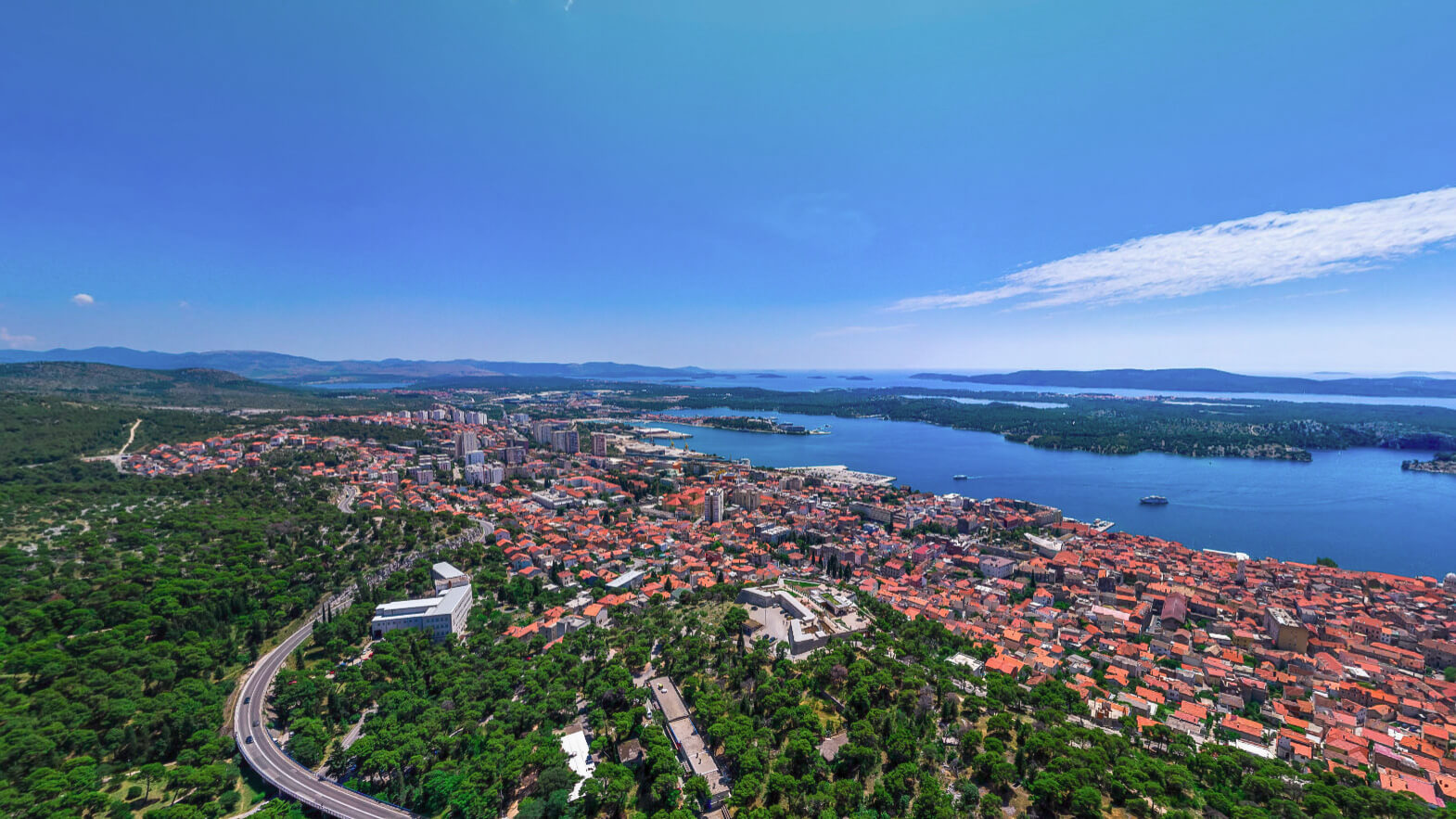 View over Šibenik, with Šubićevac Forest Park at the rear of the city © Šibenik Tourist Board
View over Šibenik, with Šubićevac Forest Park at the rear of the city © Šibenik Tourist Board
To visitors, Šubićevac Forest Park is the least famous of all Šibenik's recreational areas. A huge stretch of forestland, much loved by city residents, it rises above the city near Barone Fortress. The section of forest closest to the Šubićevac is designated as a city park. Within this part, you'll find a children's playground, specially designed to be accessible to all, including children with special needs.
 Easily accessible section of Šubićevac Forest Park © Javna ustanova Športski objekti Šibenik
Easily accessible section of Šubićevac Forest Park © Javna ustanova Športski objekti Šibenik
Throughout this section, designated paths for cycling and walking. Running to the southeast, a much larger area of near untouched forest. Here, a wilderness ripe for runners or hikers to explore. It's worth seeking out the tiny Church of St Michael here.
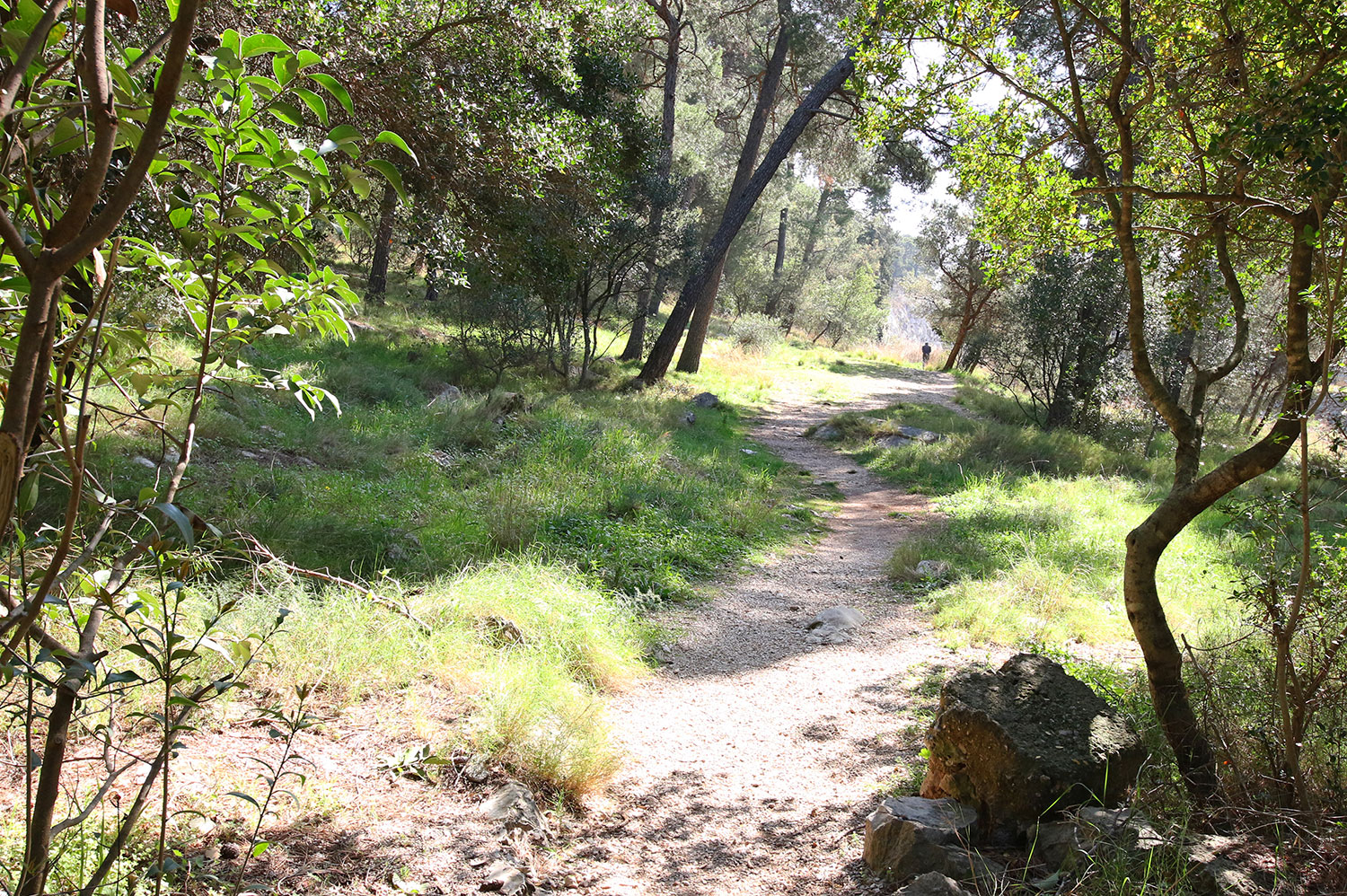 Paths through forest wilderness © Javna ustanova Športski objekti Šibenik
Paths through forest wilderness © Javna ustanova Športski objekti Šibenik
Residents say the very best views of Šibenik come from Šubićevac Forest Park. Certainly, they are breathtaking.
 The best views over the city? It's a tough one to call - Šibenik has many contenders © Javna ustanova Športski objekti Šibenik
The best views over the city? It's a tough one to call - Šibenik has many contenders © Javna ustanova Športski objekti Šibenik
Active Šibenik: Krka National Park
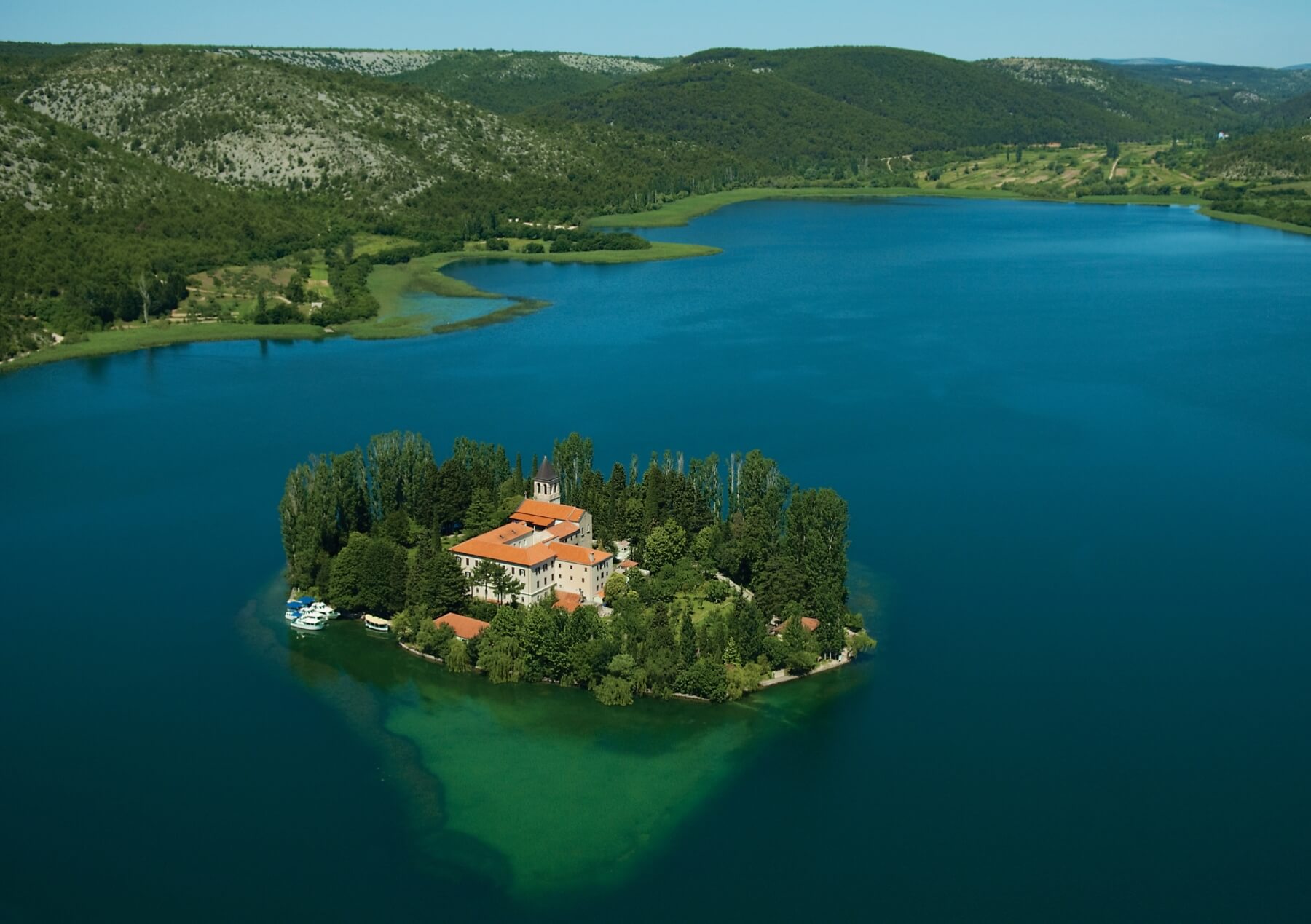 Island in Krka National Park © Šibenik Tourist Board
Island in Krka National Park © Šibenik Tourist Board
A series of wide pools, fed by cascading waterfalls, Krka is one of Croatia’s best known and most spectacular National Parks. Famous water features like the unforgettable Skradinski Buk dominate the park's postcard images. You'll find it near the park's most southerly entrance, very close to Šibenik. But, beyond this eye-catching introduction lies a further 109 square kilometers of spectacular National Park to discover. The best way to experience it is by walking, hiking or cycling.
 Countless captivating viewpoints © Krka National Park
Countless captivating viewpoints © Krka National Park
Hiking and walking trails of Krka National Park
 Walking and hiking trails © Krka National Park
Walking and hiking trails © Krka National Park
The park's hiking and walking trails give you the most thrilling views of this epic landscape and its wealth of flora and fauna. At the side of the trails, educational panels detailing the plants and animals you pass.
 Epic landscape © Krka National Park
Epic landscape © Krka National Park
There are three circular trails: Skradinski buk (1900 m), Roški Slap (1360 m) and Krka Monastery (2100 m). A walking/cycling trail also leads to Skradinski buk from the Skradin bridge (3400 m), while from Lozovac, it is possible to take a forest trail (875 m) down to the park's longest waterfall.
 Walking over waterfalls © Krka National Park
Walking over waterfalls © Krka National Park
The shortest trail is 300 m long and leads to Bilušića buk, while the longest trail is Stinice-Roški slap-Oziđana pećina and covers 8.5 kilometres. In total, there are 7 spectacular waterfalls to find as the river Krka descends through the park.
Cycling routes of Krka National Park
 Breathtaking views on the cycling and walking routes © Krka National Park
Breathtaking views on the cycling and walking routes © Krka National Park
Bicycling through Krka National Park is a journey of endless enjoyment. If your perfect cycling route offers stunning landscapes, then this is the place for you. But, if you're curious to learn about the park's cultural and historical heritage, then cycling also helps you unlock these park secrets.
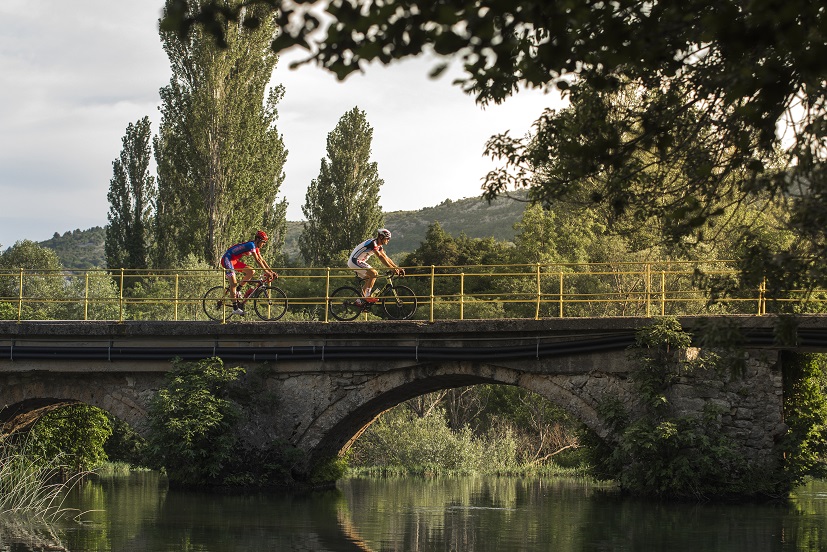 Cycling © Krka National Park
Cycling © Krka National Park
No less than fourteen cycling routes crisscross the park. They are divided into three types:
Road route - perfect for racing bikes and dedicated cyclists
Trekking & family route - a mixture of paved roads and gravel paths, perfect for city bikes, mountain bikes, families with children and cyclists of any age and ability.
Mountain biking route – a mixture of gravel paths and unarranged forest paths, with sharp ascents and descents, designed for mountain bike enthusiasts in good physical condition and with advanced cycling skills.
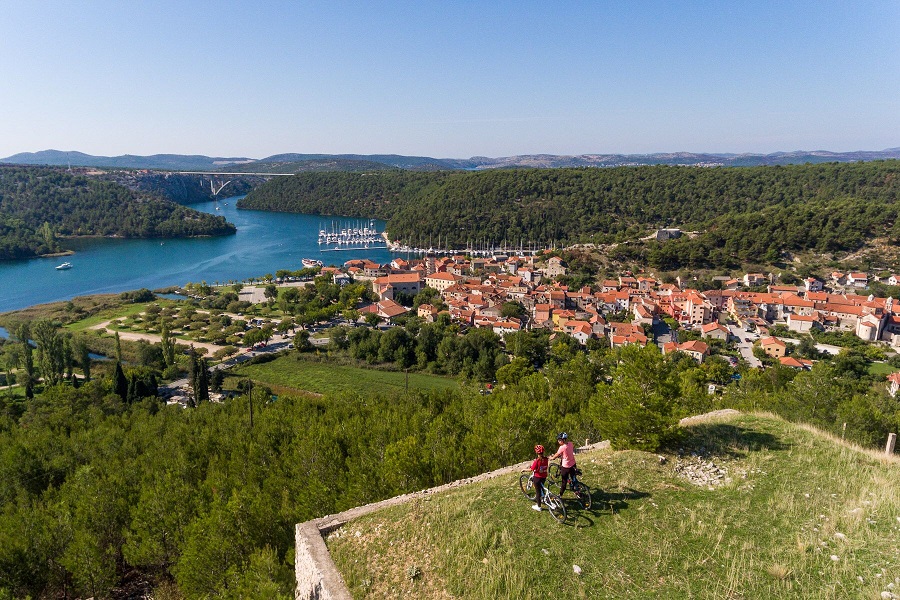 Cycling above Skradin © Krka National Park
Cycling above Skradin © Krka National Park
Šibenik zipline
On the northeast corner of the park, stretching across an epic canyon, one of Croatia's most thrilling ziplines. Flying from cliffs hundreds of metres above, so vast is the canyon that you can barely see the thrillseekers at the end of the first line. And, after that, there are still another two to go!
For more information and/or booking any of these activities, visit/contact Šibenik Tourist Board here
For more on great things to do in Šibenik, be sure to check Total Croatia News's dedicated pages here
Skradinski Buk Pond Turtles Return after Long Absence from Krka National Park
September 19, 2021 - Skradinski buk pond turtles have returned to their ideal living conditions in Krka National Park, primarily thanks to fewer visitors caused by the pandemic.
After a long absence, the strictly protected pond turtle species (Emys orbicularis) has found a haven at the foot of Europe's longest travertine barrier. An adult and two young individuals have been confirmed, reports Sibenik.in.
The pond turtle has ideal living conditions in Krka National Park. It is most numerous in the middle and upper course of the Krka river, especially along the banks near the Krka monastery: the marsh at the foot Carigradska draga is its essential habitat. Thanks to the reduction in the number of visitors caused by the pandemic, the pond turtle returned to the area of Skradinski Buk after many years. The swimming ban in Skradinski Buk has further reduced the pressure on the aquatic ecosystem, so this year they lay eggs. The natural habitats of pond turtles are stagnant and slow-flowing freshwater rich in vegetation, such as muddy-bottomed lakes, ponds, rivers, canals, floodplain forests, and brackish waters. Since it is a cold-blooded animal, it is suitable for quiet places to sunbathe, mostly on stumps and rocks.
The pond turtle is a strictly protected species: protected by the Nature Protection Act, the European Union Directive on the Protection of Natural Habitats and Wild Fauna and Flora (Habitats Directive), and the Convention on the Conservation of European Wildlife and Natural Habitats (Bern Convention). Furthermore, Emys orbicularis is the target species of the ecological network Natura 2000, a conservation area important for species and habitat types HR2000918 Krka and the surrounding plateau. The name Emys comes from the Greek word "emys" (ὲμύς), which means "freshwater turtle".
The pond turtle is also active at night when it hunts and searches the surroundings but never moves away from the water. It feeds mainly on invertebrates, most often beetles, snails, shrimp, earthworms, and tadpoles, less often on amphibians and smaller fish, and least on aquatic plants. It has a hard shell, more flattened than a land turtle and slightly wider at the back. In populations in the Mediterranean, the shell is about fifteen centimeters long. It has five well-visible toes with claws on its front legs and four on its hind legs.
Males and females are easily recognizable, primarily by size: females are larger than males. As the animal grows, so do the plates that cover the carapace (upper) and plastron (lower part of the shell). They form growth zones, with which the age of the individual can be determined by counting the rings. Like rings on a tree, they grow in concentric rings spreading from one corner. Growth largely depends on the climatic conditions where the turtle lives, so it is slowed down in winter or during the dry season. In the unfavorable season for growth, certain parts of the rings tear and darken, and in the good season, they expand. Other factors that affect growth rate are sex, habitat characteristics, diet type, and food availability.
The pond turtle chooses land-laying areas with sandy surfaces rich in necessary food and safe from predators. They have the so-called temperature-dependent determination of embryonic sex: eggs incubated at temperatures below 25° C only males will develop, and those incubated above 30° C only females will develop. The ratio of males to females due to different natural conditions during the day and night is generally 50:50. Pond turtles reach sexual maturity from 6 to 8 when they grow to a length of about 12.5 cm. They are then considered fully developed adult individuals. Their development is sensitive and depends on ecological, genetic factors, food availability, and habitat quality. The oldest record of the presence of a pond turtle in "Kerka" at "Scardone" dates from 1780 (in the work of Pietro Nutrizi Chrisogon Notizie per servire alla storia naturale della Dalmazia).
For more, follow our lifestyle section.
Krka National Park Ticket Discount: Walk for a 20% Cheaper Visit in May
April 30, 2021 - Throughout the month of May, a Krka National Park ticket discount is going to be offered in the Park's "Go and Walk" action, which provides a 20% cheaper ticket to any visitor ready to enter and exit the premises on foot.
Krka National Park, as stated on their website, is going to be inviting visitors to enter the Park on foot and get a 20 percent discount on their individual ticket price for doing so. This offer is part of the ''Go and Walk'' action, which starts on Saturday, May the 1st, and is set to continue throughout the whole month.
''The ''Go and Walk'' promotional action implies that people must enter and exit the park on foot in order to get the Krka National Park ticket discount of 20%. All of the park's other services, as well as tickets for visitors who will enter the park by boat or a bus, will be charged by as normal,'' according to Krka National Park's official website.
The discount varies pending on where you intend to go. If you decide to go to the main spectacle of the park, The Skradinski Buk waterfall by taking the hitchhiker trail, either from Lozovac or Skradinski Bridge, the promotional price is 80 kuna. Apart from Skradinski Buk, all other land localities in the park are set to be included in that price. Kids aged 7-18 accompanied by parents or guardians will have to pay only 64 kuna for their ticket, while for kids up to the age of 7, entrance to the park is free of charge.
If you decide to walk only until Roski Slap, an adult ticket will cost 40 kunas and for kids (7-18-year-olds), only 32 kuna.
The third option is also the Krka Monastary and Burnum archaeological site. An adult ticket price for that path is 32 kuna, while the children's ticket costs a mere 24 kuna.
''With the ''Go and Walk'' action, the Public Institute of Krka National Park wants to encourage the active visiting of the park, and the usage of educational-hitchhiking trails too, by reducing the usage of public transport by bus and boats and having a direct impact on lowering CO2 emissions,'' said Nella Slavica of the Public Institute of Krka National Park.

© Krka National Park
Krka National Park is also a holder of the ''Stay Safe in Croatia'' badge, and the park is being very careful in ensuring epidemical measures are respected by both the visitors and employees while informing the public about the benefits of being out in the open air during these challenging times.
Back in the former Yugoslavia, on January the 24th, 1985, the Parliament of the Socialist Republic of Croatia declared Krka a National Park, and it has enjoyed an enormous amount of popularity ever since. This gorgeous park remains a place of natural and cultural heritage, a place to learn, a place to rest, and a place to enjoy a lovely escape from the stress of modern life.
Learn more about Krka National Park on our TC page.
For more about travel in Croatia, follow TCN's dedicated page.
Visitors Choose Name 'Torak' for New Boat in Krka National Park Fleet
March 4, 2021 – Thanks to the online poll conducted with visitors and social media followers, a new boat in the Krka National Park fleet got the name Torak, after a lake-shaped spring in the center of the Krka and Čikola's fairytale confluence.
Krka National Park recently launched online voting to name a new modern ship that will start sailing in their fleet this spring. Lozovac, Torak, Čikola, and Sveti Ivan Krstitelj were the name options, and visitors could vote for the best. Today, Krka National Park published the survey results, and the new modern boat is named – Torak.
Located in the center of the fairytale confluence of the Čikola and Krka rivers, the Torak spring, due to its round shape, looks more like a lake, so it is called a lake spring. Krka National Park's friends, visitors, and followers also liked the name Torak and decided to give it to a new modern boat for sailing from Skradinski Buk to Roški Slap waterfalls.

Torak lake spring / Krka National Park
The Torak lake spring diameter is 150 meters, the depth is 30 meters, and the spring itself is located at the bottom of the lake. This karst spring amazes with its beauty because of its unusual position and the characteristic flora of the lawns and bushes surrounding it.
The name of the new boat in the Krka National Park fleet was confirmed by the Inland Navigation Directorate of the Ministry of the Sea, Transport, and Infrastructure.
A boat ride from Skradinski Buk to Roški Slap has been a special attraction since the very beginning of Krka's excursions. That is why Krka National Park strengthened its fleet with a new ship for 98 passengers and two crew members. This modern vessel has one open and one closed deck, with comfortable seats and an air conditioning system. It is equipped with a ramp and places for people with disabilities.

New modern boat Torak / Krka National Park
"Visitors especially enjoy the boat ride, so we must provide them with a complete experience of sailing on the river in our safe and modern boats," said the Krka National Park director Nella Slavica.
For the latest travel info, bookmark our main travel info article, which is updated daily.
Read the Croatian Travel Update in your language - now available in 24 languages.
Lozovac, Torak, Čikola? Choose Best Name for New Modern Boat in Krka National Park
February 12, 2021 – This spring, a new modern boat will sail along Krka National Park's favourite excursion route – from Skradinski Buk to Roški Slap waterfalls. Everything is set to sail, except for the boat's name. To contribute to Krka National Park and its offer, you can choose the name that suits the boat the best in an online poll.
As Krka National Park reports, the Public Institution of the Park strengthened its fleet with a new ship intended for 98 passengers and two crew members. Since ships' names are important and significant in maritime tradition, Krka National Park has invited the park's visitors and friends to choose the name for the new boat.
The most unusual confluence in Croatia
Name suggestions are Lozovac, Torak, Čikola, or Sv. Ivan Krstitelj (St John the Baptist) and voting is open via the following link until February the 15th. All four names are related to this particular excursion route, and a boat ride from Skradinski Buk to Roški Slap has been a unique attraction since the very beginning of excursions on Krka.

New modern boat / Photo: Krka National Park

Skradinski Buk waterfall / Photo: Romulić and Stojčić
The pier leading to the middle course of the Krka can be reached via Lozovac, the gateway to Krka National Park.
Namely, when the powerful travertine barrier of Skradinski Buk rose, Krka became a lake unto the island of Visovac, and the mouth of the Čikola river actually sank. This is how the most unusual confluence in Croatia was created.
The Kaličko sod, which is a travertine barrier of about 700 metres in length and only ten metres in width, separates Krka from the mouth of the Čikola. Thus, one sees the exact place where for thousands of years, the Čikola, after travelling through a narrow canyon, spreads wide, rushing into Krka's arms.
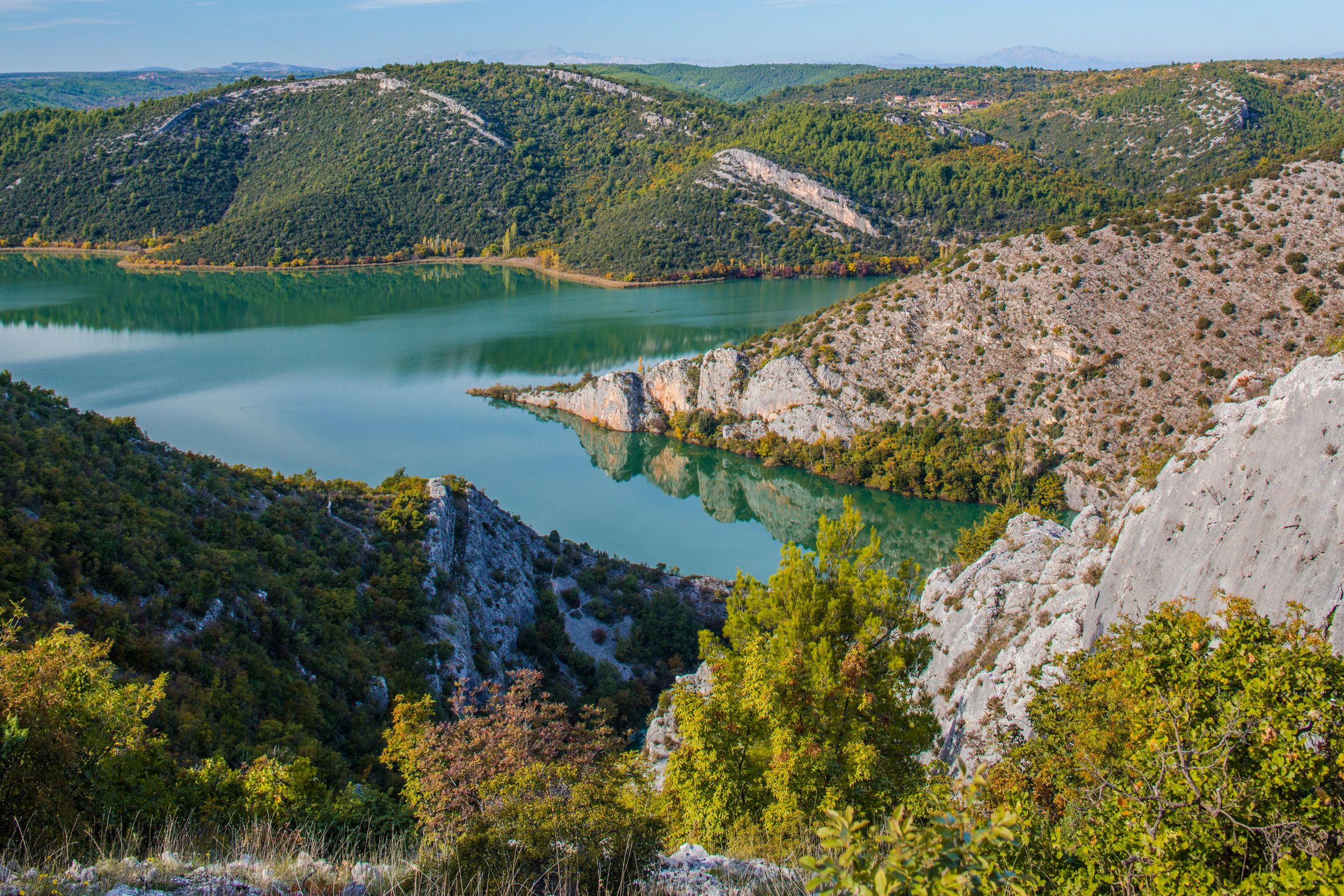

The confluence of the river Čikola and the river Krka / Photo: Romulić and Stojčić
Excursion boats sail right around the Kaličko sod, transporting visitors to the island of Visovac along the lake-like course of the river. In the centre of the fairytale confluence of the two rivers is Torak, a spring in the shape of a lake. Although it is a spring, it looks more like a lake due to its round shape, so it's referred to as a lake spring.
The whole area is under the protection of the parish of Konjevrate, over which St John the Baptist watches.
An attraction more than 100 years old
The new boat has one open and one closed deck, with comfortable seats and an air conditioning system. This modern vessel is also equipped for people with disabilities.

New modern boat / Photo: Krka National Park
"Krka National Park organises boat transport from Skradin to the Skradinski Buk waterfall and excursion boats from Skradinski Buk to Visovac and the Roški slap waterfall. The boats depart from Stinice and Remetić to Visovac, and two excursions also depart from Roški Slap. Visitors especially enjoy boating, so we must provide them with a complete experience of sailing on the river in safe and modern boats," said Nella Slavica, Krka National Park's director.
The first excursion ship that transported Roški Slap visitors to Visovac and Skradinski Buk was launched way back on March the 31st, 1912. After more than a hundred years of operation, this route is still one of the biggest attractions in the entire park and as such is always of great interest to visitors.
For the latest travel info, bookmark our main travel info article, which is updated daily.
Read the Croatian Travel Update in your language - now available in 24 languages.


